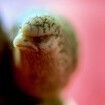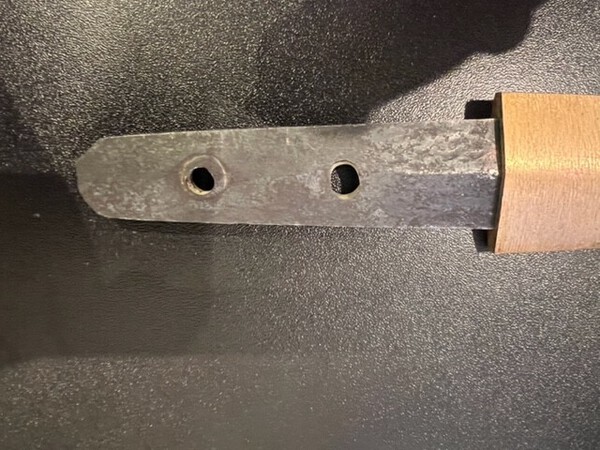-
Posts
59 -
Joined
-
Last visited
Content Type
Profiles
Forums
Events
Store
Downloads
Gallery
Everything posted by JAL
-
Thank you Steve! Some of the peculiarities are so difficult to grasp. Thanks for your quick answer. best regards John
-
-
Dear all, I am having trouble as usual with Tanobe san’s kanji. The total sayagaki I could translate but in this important part I miss the clue to some kanji. Any help would be appreciated. Best regards John L.
-
Thanks Geraint, yes, I think they are silver-plated brass looking at the wear. Nice ken as well. I agree that it might indeed be export in Meiji times. best regards John
-
-
Hi all, this ken puzzles me a bit. It is large with a nagasa of 69 cm. Nice masame hada and suguha hamon. The mounts are different from what I have seen with traditional ken that have a vajra as tsuka. Given the elaborate mounts with a lacquered tsuka I assume this ken was ceremonial (Dharma wheel also represented a couple of times on the mounts) and not a weapon. My estimation is Bakumatsu assuming the Aoi mon are original. Meiji would be a bit strange with aoi mon on all of the mounting. It still puzzles me. best regards John L.
-
Hi, Setsumei translstion best effort. Description It is said that Aritoshi was a swordmaker belonged to Yamato Taima school and he has two names: one is Aritoshi (有俊) consisting of two Chinese characters and another is Cho Aritoshi (長有俊) consisting of three Chinese characters. The former one can be seen produced in Einin 6 (1298). It is a common theory that mei of Cho Aritoshi (three Chinese characters) shows the second Aritoshi, the era is approx. Kenmu, shortened name of Chobei (no) jo Aritoshi. This sword is that jigane is koitame with slightly nagare masa, thick jinie sticked to pieces, hamon is suguha, kochoji, kogunome, kui chigai ba & niju ba & yubashiri on habuchi, thick nie is brightly saeru, etc, significantly see Cho Aritoshi’s feature on jiba (jihada and hamon) and kiwameno syuko sareru (it is proved as the past authentication.). As Cho Aritoshi’s feature, habuchi is a highlight of niju ba. This sword has strong hanie with Cho Aritoshi’s kiwame, niju ba with thick and condensed nie can be frequently seen on habuchi, hamon is clearly skillful. It is an excellent piece of work. best regards, John
-
Sayagaki of my Taima Den Cho Aritoshi states the smith being active in Kenmu era (1333-1336 so Nambokucho).
-
-
Hi all, here are some pictures of the sayagaki of my Taima. Translation in earlier post. I was not really looking for specifically Taima, but did at that time have a vested interest in Yamato. Still own a TH Kamakura tachi, a juyo Senjuin Yoshimitsu Kamakura tanto and this Taima Cho Aritoshi. best regards John
-
Hi, Nice Taima sword. Although it is stated that Taima is a somewhat rare school, I owned four blades in during twenty years of collecting and two of them attributed to Cho Aritoshi. Currently I still have in my collection a juyo token attributed to den Cho Aritoshi (62nd juyo session) with a sayagaki by Tanobe sensei which translates approximately to: Sayagaki Tanobe Sensei 62th juyo token The Wasyu Cho Aritoshi. This sword is Osuriage Mumei. This sword smith was Taima school’s student, he was a sword smith in the Kenmu era. Hamon is Suguha and Syogunome with deep and thick Nie. Also, Hamon has many Niju- ha and Yubashiri. This sword has a lot of characteristics of Aritoshi and is excellent. Nagasa 2 shaku 2 sun 2 bu Year of the Rooster 2017 best regards, John
-
Thank you Steve, yess, the length I believe is 2 shaku, 2 sun, 2 bu about 67.3 cm. I am always struggling with the description of the year, but based on your transcription this should be the year of the rooster,, so 2017 which makes sense because the juyo paper is end 2016. best regards, John
-
-
Dear all, The setsu-mei and juyo paper translation are doable but sayagaki is still a problem for me. This is a 60th juyo session yamato Taima Den Cho Aritoshi o-suriage mumei sword Kenmu era. This is as far as I got with the Tanobe -san sayagaki translation but I might not be correct. Any help would be greatly appreciated. ‘’Washu (Yamato Cho Aritoshi. This sword is Osuriage Mumei. This sword smith was Taima school’s student, he was a sword smith in the Kenmu era. Hamon is Suguha and Syogunome with deep and thick Nie. Also, Hamon has many Niju-ha and Yubashiri. This sword has a lot of characteristics of Aritoshi and is excellent.” Best regards, John
-
-
Thanks Matt, interesting, I will check it. It came with papers that stated Gassan Sadayoshi. The issuing org is quite unknown so not sure. best regards, John
-
thanks for all the help. The first part still is a bit strange to me. I was also looking in the sayagaki for the attribution (both blades are mumei but attributed to Gassan Sadayoshi) which I had expected to be on the top. Mumei Jidai Keio I could find. 信州松代 兼虎 Shinshu Matsudai Kanetora: would this be the writer of the sayagaki (Matsudai Kanetora from Shinano province?) 大互目乱れ 出来良し O gunome midare, good work best regards, john
-
Thank you Moriyama san. Clearly a couple of kanji that were off in my transcription. With this new info I will continue to do the translation. Best regards, John
-
-
Struggling with the first part of the sayagaki: Shinshuu (Shinano) 信州. 松代兼虎 and then a name or else? And then 大上目乱加出来这 . Maybe my transcription of the handwriting into the kanji is wrong? Best regards, John
-
Thank you Tom, much appreciated. the quaility of the sayagaki (ink) is quite low, polish by the way is quite good. i am still working on kanji and working on the sayagaki translation. Much more difficult than the papers…. Best regards, john
-
-
Dear NMB members, I have been trying to find out whether the kao on this sayagaki can be identified but I have not been able to find it. As a last resort I decided to post it here hoping. Otherwise it is a kao that will stay unidentified. Obviously it is not a kao from the usual appraisers and it might be insignificant but I am just curious. thanks for all the help you can provide, best regards, John
-
Thanks Mark, Yes, I love the combined design of the straight planked bridge components and curved irises. I found the tsuba you referred to https://www.bushidojapaneseswords.com/store/p399/G%234_Ko_Akasaka_iron_Tsuba_with_Iris_and_bridge.html best regards, John Lapre
-
Hi Yurie, I also enjoy reading it and would certainly buy the book. In your shinshinto/bakumatsu part you recently posted, please have a look at subscript of your picture with the Gassan Sadakazu katana. It does say Kiyomaro like in the picture above that one instead of Gassan Sadakazu. Best regards and keep up posting the updates! John








































